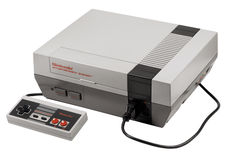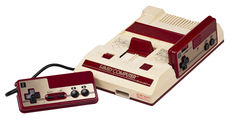Nintendo Entertainment System

| |

| |

| |
| Nintendo Entertainment System & Nintendo Family Computer (Famicom) | |
| Manufacturer | Nintendo |
|---|---|
| Generation | Third generation |
| Release date | July 15, 1983 (JP)
October 18, 1985 (NA) September 1, 1986 (EU) |
| Media type | ROM cartridge |
| Predecessor | Color TV Game (1977) |
| Successor | Super Nintendo Entertainment System (1990) |
The Nintendo Entertainment System (also abbreviated as NES or simply called Nintendo) is an 8-bit video game console that was released by Nintendo in North America during 1985, in Europe during 1986 and Australia in 1987. In Japan (where it was first launched in 1983), it was released as the Family Computer (ファミリーコンピュータ Famirī Konpyūta, commonly shortened as either the Famicom (ファミコン Famikon, or abbreviated to FC. In South Korea, it was known as the Hyundai Comboy (현대 컴보이 Hyeondae Keomboi) and was distributed by SK Hynix which then was known as Hyundai Electronics.
Contents
NES vs Famicom[edit]
Although the Japanese Famicom, North American and European NES versions included essentially the same hardware, there were certain key differences among the systems.
- The Famicom featured a top-loading cartridge slot, a 15-pin expansion port located on the unit’s front panel for accessories (as the controllers were hard-wired to the back of the console) and a red and white color scheme. The NES featured a front-loading cartridge slot and a more subdued gray, black and red color scheme. An expansion port was found on the bottom of the unit and the cartridge connector pinout was changed.
- The original Famicom and the re-released AV Family Computer both utilized a 60-pin cartridge design, which resulted in smaller cartridges than the NES, which utilized a 72-pin design.
Peripherals[edit]
A number of peripheral devices and software packages were released for the Famicom. Few of these devices were ever released outside of Japan.
- Family BASIC / Famicom BASIC
- Famicom Modem
- Famicom Disk system (A unit that used proprietary floppy disks (called "Disk Cards") for data storage)
- External sound chips: The Famicom had two cartridge pins that were originally intended to facilitate the Famicom Disk System’s external sound chip, but were also used by cartridge games to provide sound enhancements. These pins were removed from the cartridge port of the NES and relocated to the bottom expansion port. As a result, individual cartridges could not make use of this functionality and many NES localizations suffered from technologically inferior sound compared to their equivalent Famicom versions. (Castlevania III: Dracula's Curse is a notable example of this problem)
- Hardwired controllers: The Famicom’s original design includes hardwired, non-removable controllers. In addition, the second controller featured an internal microphone for use with certain games and lacked SELECT and START buttons. Both the controllers and the microphone were subsequently dropped from the redesigned AV Famicom in favor of the two seven-pin controller ports on the front panel used in the NES.
- Lockout circuitry: The Famicom contained no lockout hardware and, as a result, unlicensed cartridges were extremely common throughout Japan and the Far East. The original NES (but not the top-loading NES-101) contained the 10NES lockout chip, which increased the challenges faced by unlicensed developers.
- Audio/video output: The original Famicom featured an RF modulator plug for audio/video output, while its redesign, the AV Famicom, featured only RCA composite output. On the other hand, the original NES featured both an RF modulator and RCA composite output cables, but the top-loading NES-101 model featured only RF modulator output. The original North American NES was the first and one of the few game consoles to feature direct composite video output, and thus having the ability to be connected to a composite monitor. The French NES, model (FRA) featured a unique "RGB audio/video Output", a proprietary output connector similar to the SNES connector. With the help of an additional PAL-to-RGB chip, it allows this model of NES to output RGB video signal. A specific cable was given with every unit, using the SCART plug to connect it to the TV set.
- Third-party cartridge manufacturing: In Japan, several companies, namely Nintendo, Konami, Capcom, Namco, Bandai, Taito, Irem, Jaleco, Sunsoft and Hudson Soft, manufactured the cartridges for the Famicom, which allowed these companies to develop their own customized chips designed for specific purposes, such as Konami's VRC 6 and VRC 7 sound chips that increased the quality of sound in their games. All licensed US cartridges were made by Nintendo except Konami, Sunsoft and Acclaim (who produced their own PCBs, but used Nintendo's provided gray cartridge shells).
Hardware[edit]
The Famicom used the serial code HVC (Home Video Computer) for its hardware, while the NES simply used serial code NES.
NES serials[edit]
| Serial Number | Product Name | Note |
|---|---|---|
| NES-001 | Nintendo Entertainment System Control Deck | |
| NES-002 | AC Adapter | |
| NES-003 | RF Switch | |
| NES-004 | Controller | |
| NES-005 | Zapper (Light gun) | |
| NES-012 | R.O.B. | |
| NES-026 | NES Advantage | |
| NES-027 | NES Max Controller | |
| NES-028 | Power Pad | (The Pad features 12 buttons on each side that you use to control the action on screen. The compatible games were largely fitness titles, such as Dance Aerobics and World Class Track Meet.) |
| NES-030 | NES Cleaning Kit | |
| NES-032 | NES Satellite Remote | |
| NES-033 | NES Satellite Receiver | (A wireless, four-player adapter for the NES. The battery-powered main unit used an infra-red signal to the receiver connected to the NES to allow four players to play in the same time.) |
| NES-034 | Four Score | (Like the NES Satellite, the Four Score allowed up to four players to play in the same time. The only difference is that the Four Score was connected to the NES controller ports, meaning it did not support wireless play). |
| NES-101 | Nintendo Entertainment System (New Top-Loader Design) | |
| NES-102 | Nintendo Entertainment System (New Design) Controller |
Famicom serials[edit]
| Serial Number | Product Name |
|---|---|
| HVC-001 | Family Computer |
| HVC-002 | AC Adapter |
| HVC-003 | RF Switch |
| HVC-004 | 75/300 OHM Converter |
| HVC-005 | Kousenjuu Series Gun |
| HVC-006 | Kousenjuu Series Holster |
| HVC-007 | Keyboard (Family Basic) |
| HVC-008 | Data Recorder (Family Basic) |
| HVC-012 | Family Computer Robot |
| HVC-021 | Disk Card |
| HVC-022 | Disk Drive |
| HVC-023 | RAM Adapter |
| HVC-025 | AC Adapter for Disk Drive |
| HVC-026 | RF Extension Cord |
| HVC-027 | Cleaning Kit: Card Cleaner |
| HVC-028 | Cleaning Kit: Cartridge |
| HVC-029 | Cleaning Kit: Head Cleaning Spray |
| HVC-030 | Cleaning Kit: Head Cleaning Card |
| HVC-031 | 3D System Scope |
| HVC-032 | 3D System Adapter |
| HVC-050 | Network System |
| HVC-051 | Network Controller (Famicom Network System) |
| HVC-053 | Modular Cable (Famicom Network System) |
| HVC-054 | Telephone Switch (Famicom Network System) |
| HVC-101 | New Famicom (Top-Loader) |
| HVC-102 | New Famicom Controller |
| HVC-103 | New Famicom RF Modulator |
Power Supply[edit]
| Power Specifications | |
|---|---|
| Input | 120V AC 60Hz 17W |
| Output | 9V AC 1.8A |
Add-ons[edit]
Clones[edit]
- Terminator 2 (Super Design Ending-Man BS-500 AS)
Variants[edit]
- Main article: Twin Famicom
The Twin Famicom was a Famicom with the Disk System add-on built into it.
- Main article: Famicom Titler
The Famicom Titler was a Famicom that functioned as a subtitle generation and could be used in combination with a RF-video camera to create gameplay videos and demos.
Common problems[edit]
Front loading NES systems tend to suffer from bad pin connectors. There are lots of resources available online to buy new ones, and replacing them is very easy. All that is required is a new pin connector and a Phillips head screw driver. While the fix is simple, there are also many guides online for those in need. Alternatively you can try boiling the connector, which while not guaranteed to work, has worked for many. Just ensure that the connector is completely dry before reinstalling it: just because it appears to be dry does not mean it is.

